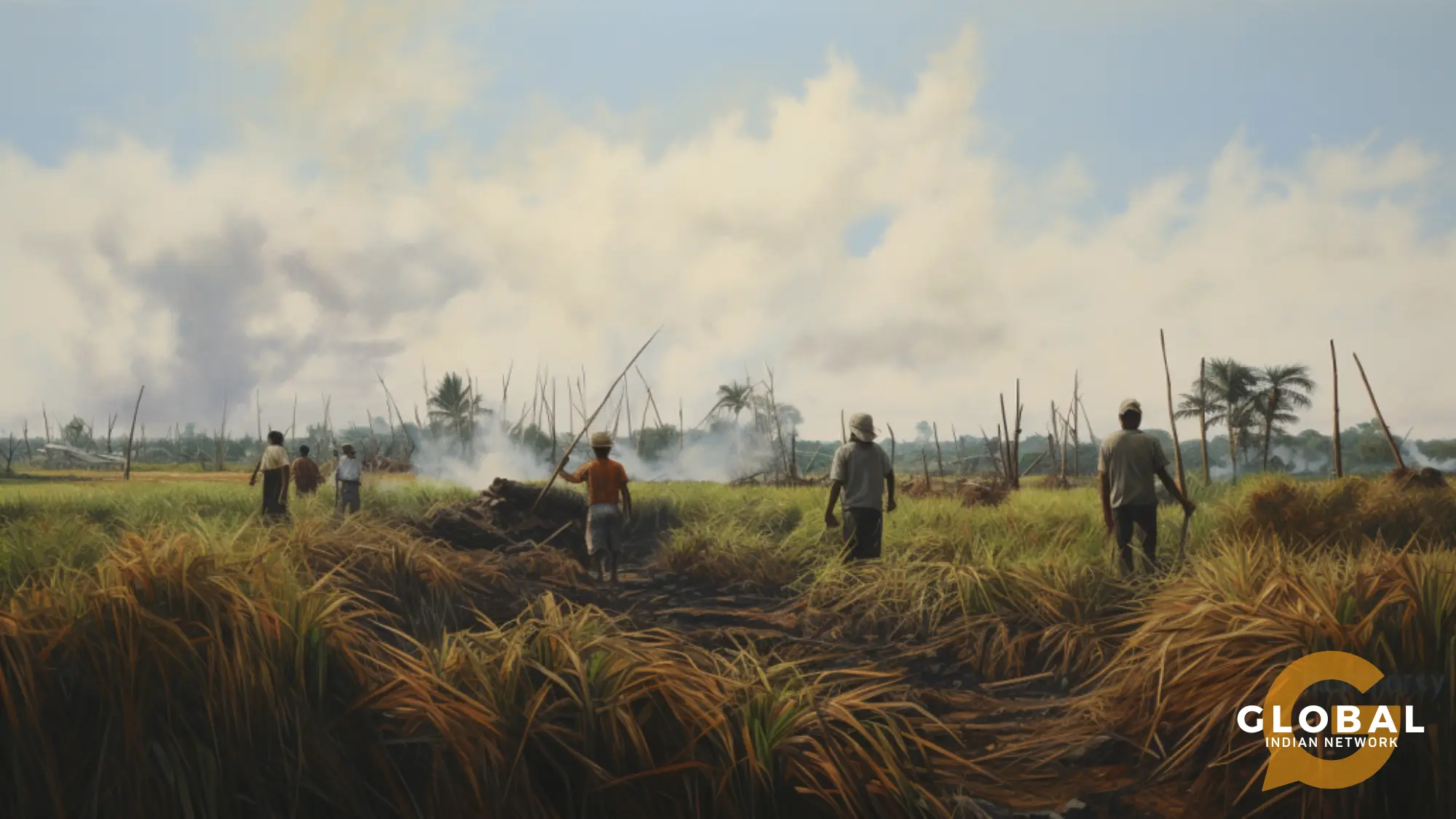The story of Girmitiyas is one of the lesser-known but incredibly important chapters in the history of Indian migration. The term "Girmitiyas" refers to the Indian indenture labourers who were brought to a foreign land, Fiji between 1879 and 1916 to work on sugarcane plantations under brutal conditions. According to historical records, over 60,000 Indians were brought to Fiji and other indenture colonies as Girmitiyas during this period. These labourers faced immense struggles and hardships, including long working hours, poor living conditions, and physical and emotional abuse. Despite these challenges, the Girmitiyas managed to form a unique cultural identity and make significant contributions to Fiji's society and economy. In this blog, we will talk more about the story of Girmitiyas, their struggles, and their lasting legacy in Fiji and beyond.
Table of Contents
History of Indenture Laborers in Fiji
Girmitiyas were Indian indentured labourers who were brought to Fiji by the colonial government between 1879 and 1916 to work on sugarcane plantations. The word "Girmit" is a corruption of the English word "agreement," which refers to the contract that the labourers signed. The Girmitiyas were mostly from north India, including Bihar and Uttar Pradesh, and were promised a better life in Fiji. However, the reality was far from it. They were treated as commodities and were subjected to inhumane treatment, poor working conditions, and little pay. They were forced to work long hours in harsh weather conditions and were not allowed to leave the plantations. The indenture system was abolished in 1920, but the impact of this era on the Indian community in Fiji is still felt today. The Girmitiyas played a significant role in shaping the cultural, social, and political landscape of Fiji and other British colonies.
Life of Girmitiyas on Sugarcane Plantations and Indenture Colonies
The life of Girmitiyas on sugarcane plantations and indenture colonies was extremely challenging. They were forced to work for long hours in harsh and inhumane conditions, often without adequate food and shelter. They had to perform physically demanding tasks such as clearing forests, planting and harvesting sugarcane, and maintaining irrigation systems. They were also subjected to severe punishment and brutal treatment by the overseers if they failed to meet their quotas or violated any rules.
In addition to the difficult work conditions, the Girmitiyas also faced numerous cultural and social challenges. They were forced to leave their homes and families behind in India and were often unable to communicate with their loved ones for many years. They had to adapt to a new language, new customs, and new religious practices, which often resulted in a loss of cultural identity and a sense of dislocation.
Resistance and Revolt against Indenture System
The Girmitiyas faced harsh living and working conditions on the sugarcane plantations, which led to resistance and revolts against the indenture system. Many Girmitiyas saw themselves as victims of a new form of slavery, with the promise of better living conditions and wages remaining unfulfilled. They protested against the exploitative system and challenged the authorities. The abolishment of slavery in the British Empire in 1834 was seen as a victory by many, but the indenture system was still a form of forced labour and was opposed by many. The Girmitiyas organized strikes, boycotts, and other forms of protests to demand better living and working conditions. These protests were often met with violence and repression, but they continued to resist the system until the indenture system was finally abolished in 1920.
Cultural Identity and Contributions of Girmitiyas
The Girmitiyas had a unique cultural identity that was shaped by their Indian roots, their experiences in European colonies, and their struggles as indentured labourers. Despite the harsh living and working conditions on the sugar plantations, they managed to preserve their cultural practices and traditions, including language, religion, music, and dance. They also adapted to their new environment and learned from the cultures of the other labourers on the plantations, including African and Chinese workers. Over time, the Girmitiyas made significant contributions to Fiji's cultural heritage, including in areas such as cuisine, music, art, and literature. Their legacy continues to be celebrated in Fiji and beyond, as a testament to their resilience, creativity, and enduring spirit.
Legacy of Girmitiyas in Fiji and Beyond
The Girmitiyas and their legacy have had a lasting impact on Fiji and beyond. The descendants of Girmitiyas have become an integral part of Fijian society and have made significant contributions to the country's economy and culture. The sugarcane industry, which was the primary reason for the arrival of Girmitiyas, remains a vital part of Fiji's economy to this day. Many of the cultural practices and traditions of Girmitiyas have also been passed down through generations and have become an essential part of Fiji's diverse cultural heritage. Moreover, the experiences of Girmitiyas have served as a symbol of resistance against oppressive systems and the white race, and their struggles have inspired social justice movements across the world. The legacy of Girmitiyas is a reminder of the resilience and strength of the human spirit, even in the face of adversity.
Conclusion
The story of Girmitiyas is a tale of hardship, perseverance, and resilience. They left their homes in India (Uttar Pradesh, Bihar) to work as indentured labourers on sugarcane plantations in European colonies, including Fiji. Their experiences were marked by exploitative working conditions, cultural alienation, and resistance against the indenture system and abolition of slavery. Despite these struggles, Girmitiyas managed to carve out a new life in Fiji and make significant contributions to its society and culture. Their legacy extends beyond Fiji and serves as a testament to the strength and determination of the human spirit. By learning about the story of Girmitiyas, we can gain a better understanding of the complexities of colonialism, migration, and cultural identity.
FAQs
Who is called Girmitiya?
Girmitiya refers to a group of people who were brought to Fiji, Mauritius, South Africa, and other countries from India to work as indentured labourers on sugar plantations during the 19th and early 20th centuries.
Which countries are Girmitiya?
The countries where Girmitiya were brought include:
Fiji, Mauritius, South Africa, Guyana, Suriname, Trinidad and Tobago, Jamaica, Reunion Island, Guadeloupe, and Martinique.
These countries have significant populations of people of Indian origin who are descendants of the Girmitiya labourers and have contributed to the cultural diversity and heritage of these regions.
What is Girmit Day?
Girmit Day, also known as Abolition of Indenture Day, is an annual observance that commemorates the end of the indentured labour system in Fiji. On this day, which is celebrated on May 14th, Fijians of Indian descent honour the struggles and sacrifices of their ancestors who were brought to Fiji as indentured labourers during the 19th and early 20th centuries.











[…] all those who made agreements with the colonial government to go abroad came to be known as "Girmitiyas." While most of those who fell victim to the Girmitiya system were sent to British colonies, a […]
[…] Immigrants: Indian labourers were brought to South Africa as indentured servants in the late 19th and early 20th centuries. They […]
[…] history's shadows, where sweat and perseverance build dreams that line the pockets of oppressors. Indentured labour, an agonising reality, thrives in colonialism's depths – from sugar, cotton, and tea plantations […]